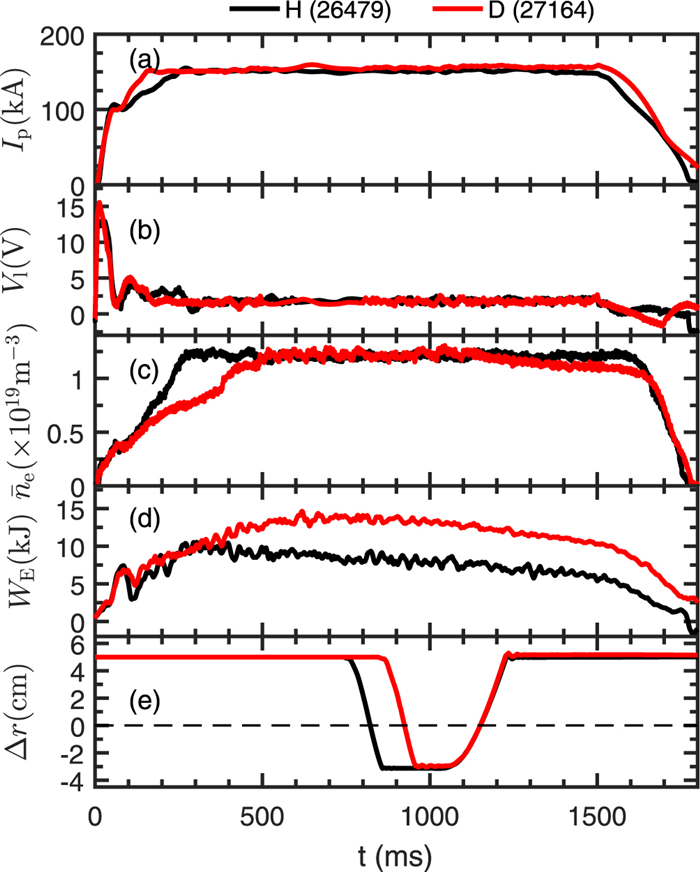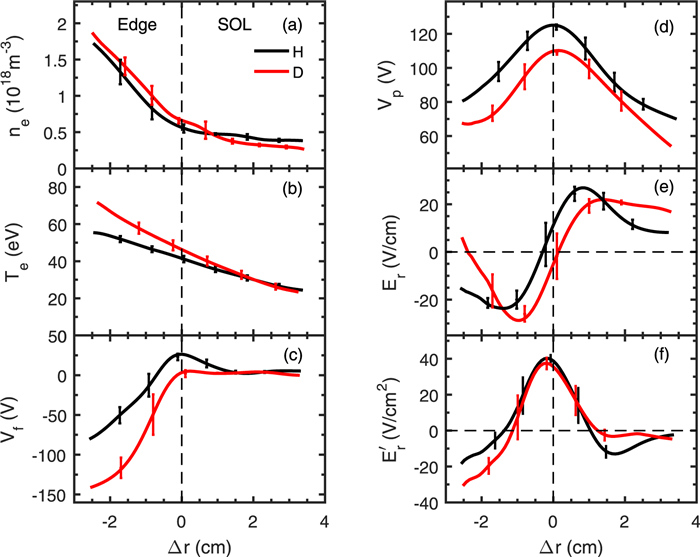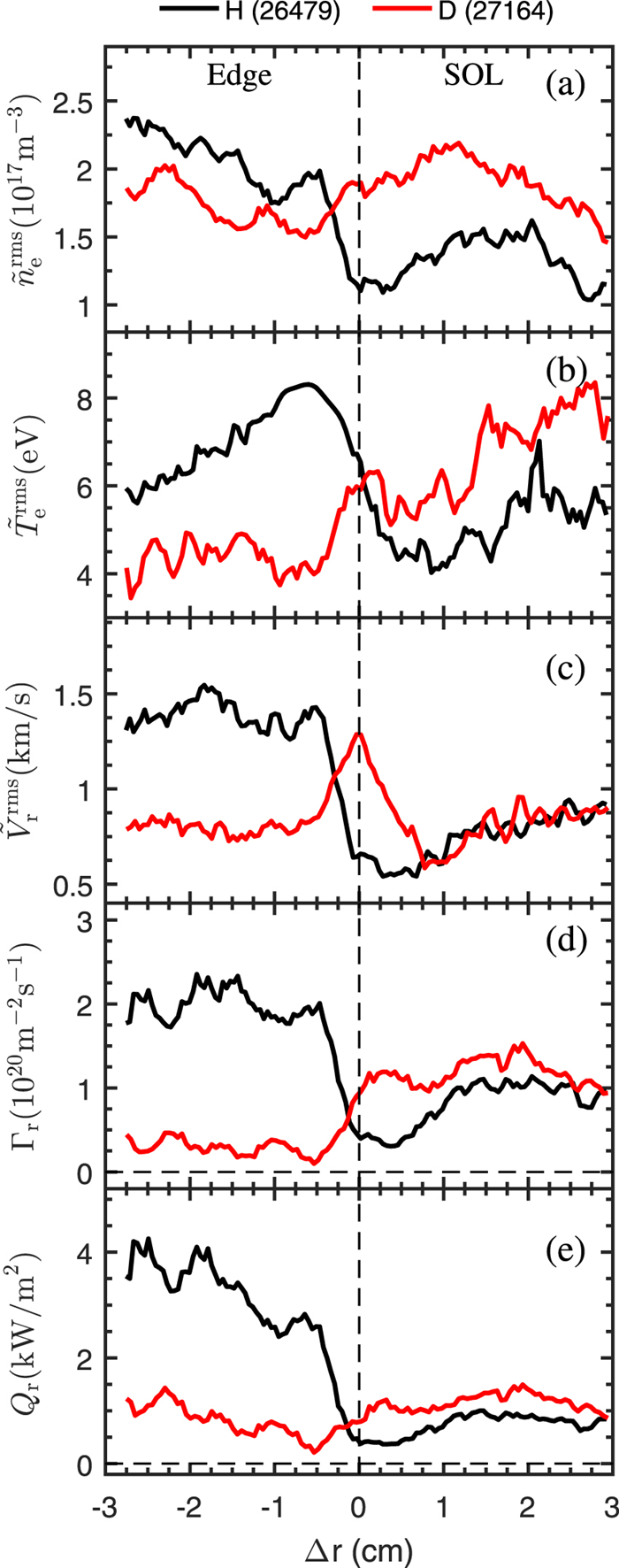
| Citation: | Yu HE, Jun CHENG, Yuhong XU, Qian FANG, Yucai LI, Jianqiang XU, Weice WANG, Longwen YAN, Zhihui HUANG, Na WU, Min JIANG, Zhongbing SHI, Yi LIU, Wulyu ZHONG, Min XU. Impact of the mass isotope on plasma confinement and transport properties in the HL-2A tokamak[J]. Plasma Science and Technology, 2022, 24(9): 095102. DOI: 10.1088/2058-6272/ac6356 |
The impact of the mass isotope on plasma confinement and transport properties has been investigated in Ohmically-heated hydrogen and deuterium plasmas in the HL-2A tokamak. Experimental results show that under similar discharge parameters the deuterium plasma has better confinement and lower turbulent transport than the hydrogen one, and concomitantly, it is found that the magnitude of geodesic acoustic mode zonal flows, the tilting angle of the Reynolds stress tensor and the turbulence correlation lengths are all larger in the edge region of the deuterium plasma. The results provide direct experimental evidence on the importance of the nonlinear energy coupling between ambient turbulence and zonal flows for governing the isotope effects in fusion plasmas.
The influence of the isotope mass on plasma confinement properties has been a longstanding issue in magnetically confined plasmas. According to gyro-Bohm scaling [1, 2], the plasma transport diffusivity scales as
The first experimental observation in the TEXTOR tokamak has demonstrated that the amplitude of geodesic acoustic mode (GAM) zonal flows substantially increases during the transition from H to D dominated plasmas [9], which is qualitatively consistent with the GKV simulation [17]. However, up to date, there has been little evidence showing the increase of nonlinear interplay between ambient turbulence and zonal flows in heavier mass isotope plasmas.
In this paper, we present direct experimental evidence to expose the fact that in D majority plasmas, the nonlinear energy transfer plays a dominant role in exciting larger GAM zonal flows by extracting more energy from ambient turbulence, which results in lower turbulent transport and better confinement compared to H majority plasmas. The results provide additional proof for understanding the isotope effects in fusion plasmas.
The experiments were carried out in the Ohmically-heated H and D plasmas at the HL-2A tokamak with a limiter configuration. The major and minor radii are R = 165 cm and a = 40 cm, respectively, line-averaged plasma density
Typical discharge waveforms in H and D dominant plasmas are plotted in figure 1. It can be seen that with the same plasma current, loop voltage and line-averaged density, the plasma stored energy in D majority plasmas is higher than that in H ones, similar to those observed in other devices [4, 5, 7, 8, 10–12, 16]. Figure 1(e) shows time traces of the reciprocating Langmuir probes plunged in the stationary phase of the H and D discharges. The probe measurement in both discharges passed through approximately the same radial locations. It has been confirmed that the plasma horizontal position kept almost unchanged as the probes plunged into the plasma. Figure 2 depicts the edge equilibrium profiles averaged in several similar H (black) and D (red) majority discharges. Here, the ∆r = 0 denotes the LCFS location. As shown in figures 2(a) and (b), the local ne and Te in the edge region (inside the LCFS, ∆r < 0) are both enhanced in D plasmas, suggesting a higher edge pressure gradient, in agreement with higher stored energy achieved in the D plasma (see figure 1(d)). Inside the LCFS, both Vf and Vp are substantially lower in D plasmas than in H ones, leading to a slightly deeper Er well and larger Er shear (
In order to gain an insight into the isotope effects on turbulence levels and associated transport, we compared the RMS values of density, electron temperature and radial velocity fluctuations,
To understand the mechanisms responsible for the reduction of turbulent transport in the isotope deuterium plasmas, we analyzed the spectrum characteristics of edge turbulence and zonal flows in H and D plasmas. In HL-2A, a low frequency coherent mode with long-range toroidal correlations, namely GAM zonal flows, has been routinely observed in floating potential signals [32, 33]. Theories predict that the GAM zonal flow has poloidally symmetric (m/n = 0/0) potential and asymmetric (m/n = 1/0) density perturbations [34, 35]. In the present experiments, it is found that the maximum GAM amplitude presents at ∆r ≈ -3 cm inside the LCFS [36]. Plotted in figure 4 are the frequency spectra of floating potential (
According to theories [34, 35], the GAM frequency
To further compare the strength of the nonlinear coupling in turbulence between H and D plasmas, the squared auto-bicoherence [38], defined as b2(f1, f2) = |B(f1, f2)|2/(〈|X(f1)X(f2)|2〉〈|X(f1 ± f2)|2〉), where B(f1, f2) = 〈X(f1)X(f2)X*(f1 ± f2)〉 and X(f) is the Fourier transform of the fluctuation signal x(t), has been computed. Figures 6(a) and (b) show contour-plots of the squared auto-bicoherence estimated by floating potential fluctuation signals measured at ∆r ≈ - 3 cm in D and H dominant plasmas. It is clear that the bicoherence along the f2 = ±10 kHz and f2 = - f1 ± 10 kHz lines are much more prominent in D plasmas than that in H ones. This comparison illustrates stronger nonlinear coupling occurred between GAM zonal flows and turbulence in D plasmas. The summation of the squared bicoherence is calculated as
In summary, the isotope effects on plasma confinement, edge turbulence and turbulent transport as well as GAM zonal flows have been studied using a two-step Langmuir probe array in H and D majority plasmas in the HL-2A tokamak. Evidence shows that under similar discharge parameters the D plasma has better confinement and lower turbulent transport than the H plasma. Meanwhile, it is observed that the magnitude of GAM zonal flows, the tilting angle of the Reynolds stress tensor, and the turbulence correlation lengths are all larger in the edge region of the D plasma. The results provide direct experimental proof on the importance of the nonlinear energy transfer between turbulence and zonal flows for governing the isotope effects in fusion plasmas.
The authors thank to the HL-2A team for their operational assistance in the experiment. This work was partially supported by National Natural Science Foundation of China (Nos. 11820101004, 11875017, 12075079 and 51821005) and partially supported by the National Key R & D Program of China (No. 2019YFE03020000), the National Magnetic Confinement Fusion Science Program of China (No. 2018YFE0310300), the Science and Technology Plan Project in Sichuan Province of China (No. 2020YFSY0047) and Sichuan International Science and Technology Innovation Cooperation Project (No. 2021YFH0066).
| [1] |
Horton W 1999 Rev. Mod. Phys. 71 735 doi: 10.1103/RevModPhys.71.735
|
| [2] |
Weisen H et al 2020 J. Plasmas Phys. 86 905860501 doi: 10.1017/S0022377820000781
|
| [3] |
Bessenrodt-Weberpals M et al 1993 Nucl. Fusion 33 1205 doi: 10.1088/0029-5515/33/8/I09
|
| [4] |
Stroth U et al 1995 Phys. Scr. 51 655 doi: 10.1088/0031-8949/51/5/019
|
| [5] |
Barnes C W et al 1996 Phys. Plasmas 3 4521 doi: 10.1063/1.872069
|
| [6] |
Scott S D et al 1995 Phys. Plasmas 2 2299 doi: 10.1063/1.871253
|
| [7] |
Urano H et al 2012 Phys. Rev. Lett. 109 125001 doi: 10.1103/PhysRevLett.109.125001
|
| [8] |
Urano H et al 2012 Nucl. Fusion 52 114021 doi: 10.1088/0029-5515/52/11/114021
|
| [9] |
Xu Y et al 2013 Phys. Rev. Lett. 110 265005 doi: 10.1103/PhysRevLett.110.265005
|
| [10] |
Schneider P A et al 2017 Nucl. Fusion 57 066003 doi: 10.1088/1741-4326/aa65b3
|
| [11] |
Maggi C F et al 2018 Plama Phys. Control. Fusion 60 014045 doi: 10.1088/1361-6587/aa9901
|
| [12] |
Maggi C F et al 2019 Nucl. Fusion 59 076028 doi: 10.1088/1741-4326/ab1ccd
|
| [13] |
Ohshima S et al 2021 Plama Phys. Control. Fusion 63 104002 doi: 10.1088/1361-6587/ac1837
|
| [14] |
Liu B et al 2015 Nucl. Fusion 55 112002 doi: 10.1088/0029-5515/55/11/112002
|
| [15] |
Yamada H et al 2019 Phys. Rev. Lett. 123 185001 doi: 10.1103/PhysRevLett.123.185001
|
| [16] |
Tanaka K et al 2019 Nucl. Fusion 59 126040 doi: 10.1088/1741-4326/ab4237
|
| [17] |
Nakata M et al 2017 Phys. Rev. Lett. 118 165002 doi: 10.1103/PhysRevLett.118.165002
|
| [18] |
Angioni C et al 2018 Phys. Plasmas 25 082517 doi: 10.1063/1.5045545
|
| [19] |
Bonanomi N et al 2019 Nucl. Fusion 59 126025 doi: 10.1088/1741-4326/ab3ecc
|
| [20] |
Garcia J et al 2017 Nucl. Fusion 57 014007 doi: 10.1088/1741-4326/57/1/014007
|
| [21] |
Manas P et al 2019 Nucl. Fusion 59 014002 doi: 10.1088/1741-4326/aaeeb5
|
| [22] |
Bustos A et al 2015 Phys. Plasmas 22 012305 doi: 10.1063/1.4905637
|
| [23] |
Hahm T S et al 2013 Nucl. Fusion 53 072002 doi: 10.1088/0029-5515/53/7/072002
|
| [24] |
Watanabe T H et al 2011 Nucl. Fusion 51 123003 doi: 10.1088/0029-5515/51/12/123003
|
| [25] |
Garbet X et al 1997 Plama Phys. Control. Fusion 39 B91 doi: 10.1088/0741-3335/39/12B/007
|
| [26] |
Pusztai I et al 2011 Phys. Plasmas 18 122501 doi: 10.1063/1.3663844
|
| [27] |
Chen S L et al 1965 J. Appl. Phys. 36 2363 doi: 10.1063/1.1714492
|
| [28] |
Stangeby P C et al 1990 Nucl. Fusion 30 1225 doi: 10.1088/0029-5515/30/7/005
|
| [29] |
Boedo J A et al 1999 Rev. Sci. Instrum. 70 2997 doi: 10.1063/1.1149888
|
| [30] |
Wootton A J et al 1990 Phys. Fluids B 2 2879 doi: 10.1063/1.859358
|
| [31] |
Yan L W et al 2005 Rev. Sci. Instrum. 76 093506 doi: 10.1063/1.2052049
|
| [32] |
Zhao K J et al 2006 Phys. Rev. Lett. 96 255004 doi: 10.1103/PhysRevLett.96.255004
|
| [33] |
Yan L W et al 2007 Nucl. Fusion 47 1673 doi: 10.1088/0029-5515/47/12/005
|
| [34] |
Winsor N et al 1968 Phys. Fluids 11 2448 doi: 10.1063/1.1691835
|
| [35] |
Diamond P H et al 2005 Plama Phys. Control. Fusion 47 R35 doi: 10.1088/0741-3335/47/5/R01
|
| [36] |
He Y et al 2022 Nucl. Fusionsubmitted doi: 10.1088/1741-4326/ac7c28
|
| [37] |
Lao L L et al 1990 Nucl. Fusion 30 1035 doi: 10.1088/0029-5515/30/6/006
|
| [38] |
Kim Y C et al 1979 IEEE Trans. Plasma Sci. PS-7 120 doi: 10.1109/TPS.1979.4317207
|
| [39] |
Xu Y et al 2013 Nucl. Fusion 53 072001 doi: 10.1088/0029-5515/53/7/072001
|
| [40] |
Shesterikov I et al 2013 Phys. Rev. Lett. 111 055006 doi: 10.1103/PhysRevLett.111.055006
|
| [41] |
Liu B et al 2016 Nucl. Fusion 56 056012 doi: 10.1088/0029-5515/56/5/056012
|
| [42] |
Ramisch M et al 2005 Phys. Plasmas 12 032504 doi: 10.1063/1.1857531
|
| [43] |
Tokar M Z et al 2004 Phys. Rev. Lett. 92 215001 doi: 10.1103/PhysRevLett.92.215001
|
| [1] | Ting WU, Lin NIE, Yi YU, Jinming GAO, Junyan LI, Huicong MA, Jie WEN, Rui KE, Na WU, Zhihui HUANG, Liang LIU, Dianlin ZHENG, Kaiyang YI, Xiaoyan GAO, Weice WANG, Jun CHENG, Longwen YAN, Laizhong CAI, Zhanhui WANG, Min XU. Evolution of edge turbulent transport induced by L-mode detachment in the HL-2A tokamak[J]. Plasma Science and Technology, 2023, 25(1): 015102. DOI: 10.1088/2058-6272/ac82df |
| [2] | W BUANGAM, J GARCIA, T ONJUN, JET Contributors. Impact of E × B flow shear stabilization on particle confinement and density peaking at JET[J]. Plasma Science and Technology, 2020, 22(6): 65101-065101. DOI: 10.1088/2058-6272/ab7b0e |
| [3] | Wenjia WANG (王文家), Deng ZHOU (周登), Yue MING (明玥). The residual zonal flow in tokamak plasmas with a poloidal electric field[J]. Plasma Science and Technology, 2019, 21(1): 15101-015101. DOI: 10.1088/2058-6272/aadd8e |
| [4] | Zhongbing SHI (石中兵), Wulyu ZHONG (钟武律), Min JIANG (蒋敏). Progress of microwave diagnostics development on the HL-2A tokamak[J]. Plasma Science and Technology, 2018, 20(9): 94007-094007. DOI: 10.1088/2058-6272/aad27b |
| [5] | K J ZHAO (赵开君), J Q DONG (董家齐), J Q LI (李继全), LW YAN (严龙文). A brief review: experimental investigation of zonal flows and geodesic acoustic modes in fusion plasmas[J]. Plasma Science and Technology, 2018, 20(9): 94006-094006. DOI: 10.1088/2058-6272/aad382 |
| [6] | Jan WEILAND. The role of zonal flows in reactive fluid closures[J]. Plasma Science and Technology, 2018, 20(7): 74007-074007. DOI: 10.1088/2058-6272/aab20d |
| [7] | Wulyu ZHONG (钟武律), Xiaolan ZOU (邹晓岚), Zhongbing SHI (石中兵), Xuru DUAN (段旭如), Min XU (许敏), Zengchen YANG (杨曾辰), Peiwan SHI (施培万), Min JIANG (蒋敏), Guoliang XIAO (肖国梁), Xianming SONG (宋显明), Jiaqi DONG (董家齐), Xuantong DING (丁玄同), Yong LIU (刘永), HL-A team (HL-A团队). Dynamics of oscillatory plasma flows prior to the H-mode in the HL-2A tokamak[J]. Plasma Science and Technology, 2017, 19(7): 70501-070501. DOI: 10.1088/2058-6272/aa6538 |
| [8] | Hailin ZHAO (赵海林), Tao LAN (兰涛), Adi LIU (刘阿娣), Defeng KONG (孔德峰), Huagang SHEN (沈华刚), Jie WU (吴捷), Wandong LIU (刘万东), Changxuan YU (俞昌旋), Wei ZHANG (张炜), Guosheng XU (徐国盛), Baonian WAN (万宝年). Zonal flow energy ratio evolution during L-H and H-L transitions in EAST plasmas[J]. Plasma Science and Technology, 2017, 19(3): 35101-035101. DOI: 10.1088/2058-6272/19/3/035101 |
| [9] | LIN Zhihong (林志宏), S. ETHIER, T. S. HAHM, W. M. TANG. Verification of Gyrokinetic Particle Simulation of Device Size Scaling of Turbulent Transport[J]. Plasma Science and Technology, 2012, 14(12): 1125-1126. DOI: 10.1088/1009-0630/14/12/17 |
| [10] | T. WATARI, Y. HAMADA. Linear Gyro-Kinetic Response Function for Zonal Flows[J]. Plasma Science and Technology, 2011, 13(2): 157-161. |
| 1. | Qin, C., Huang, J., Li, M.-S. The isotope effect on ion temperature gradient mode in CFQS | [CFQS 中离子温度梯度模的同位素效应研究]. Hejubian Yu Dengliziti Wuli/Nuclear Fusion and Plasma Physics, 2024, 44(3): 359-366. DOI:10.16568/j.0254-6086.202403017 | |
| 2. | Zhou, H., Xu, Y., Kobayashi, M. et al. Isotope effects on transport characteristics of edge and core plasmas heated by neutral beam injection (NBI) in an inward shifted configuration at the Large Helical Device. Nuclear Fusion, 2024, 64(3): 036023. DOI:10.1088/1741-4326/ad22f6 |

